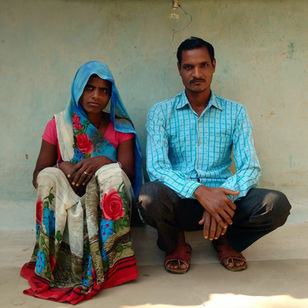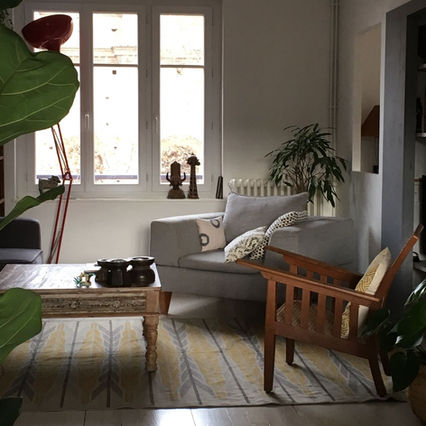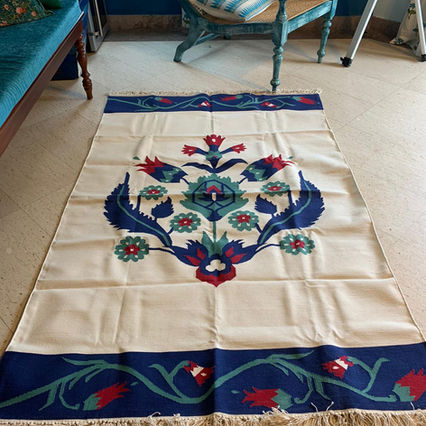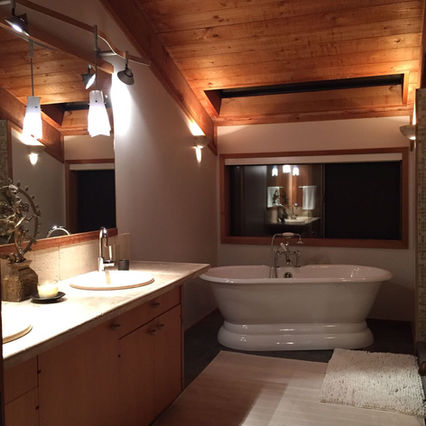

ABOUT US
Kalāvilāsa is a brand of Forum For Rural Weavers, a not-for-profit company working towards protecting India’s cultural heritage and providing rural livelihoods. It works with artisan groups in central India to create exquisite hand woven punja dhurries and cushion covers. Each dhurrie is hand-made on a traditional wooden loom using weaving techniques which have been passed through generations. Most of the weavers work in Hatwa village in Madhya Pradesh, and live in the vicinity.

OUR TEAM


THE STORY OF HATWA
VILLAGE
Situated to the north of the mighty Sone river, Hatwa village lies in the foothills of Kaimur hills in central India. Landholdings are small, soil is fertile, and people practice rain-fed, and largely subsistence farming. Because of a lack of industries, the area has practically no employment opportunities outside agriculture. Consequently, most of the able young men leave for work to the more prosperous states. In the earlier days, many people from the village were employed in the weaving workshops in the neighboring state of Uttar Pradesh. That work has reduced to a trickle now, and many weavers have taken up alternate professions. Kalavilasa has tapped into this base of weavers to provide them work in their native villages. The number of weavers is dwindling, as the youth are more inclined to work in the cities which appear attractive, and urban work is considered a move up the social ladder.

HISTORY
DATING DHURRIES BACK IN TIME
Flat-weave rugs are called dhurries in India. They have been woven for centuries, perhaps more than a millenium. Dhurrie was primarily a utilitarian textile, being used for purposes such as covering a wooden bed, or seating people on a bare floor, or as a prayer mat. The design of the dhurrie was simple, and typically featured stripes. It was always made of cotton, and was woven in households.

Carpet weaver in Lucknow,1871.
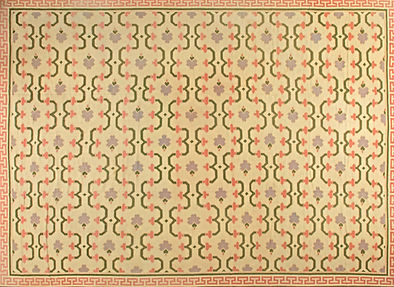
A vintage dhurrie based on carpet.
In the 16th century, Mughal kings brought carpet and its weavers from Persia to India. Unlike a dhurrie, it was a decorative textile which had a pile, and was made of wool and silk. The design of a carpet influenced the dhurrie design, which the Indian artisans readily adopted and internalized. Indian motifs like lotus and peacock were added to the design portfolio. To cater to demands from Europe, pictorial and floral designs were woven in the dhurrie. During colonial rule in India, the British found a novel use of dhurrie by getting the prisoners to weave dhurries in Indian jails. To this day, the best vintage dhurries are the ones made in a jail.
The Rajasthan Maharajas were enamored by the Persian kilims, a flat-weave rug admired for its geometrical patterns and earthy hues . Made of wool, these kilims were unsuitable for the hot weather in Rajasthan. The local artisans were asked to make decorative cotton dhurries, a first in India. Unlike kilims, the Rajasthan cotton dhurries were made in bright colours, and used local motifs.

A vintage stripes dhurrie.

Natural traders, the British encouraged Indian artisans to make wool dhurries, primarily for export to the UK. After independence, the patronage of Maharajas diminished in Rajasthan and the British owners of wool dhurrie workshops left India. Since then, dhurries have made a comeback as a chic rug in the world of home textiles.
A wool dhurrie made in colonial India.



DHURRIES IN THE 21ST
CENTURY
A dhurrie doesn’t have a pile, which distinguishes it from a tufted or a knotted rug. There are mainly three kinds of dhurries – punja dhurrie, hand loom dhurrie, and printed dhurrie. Woven using the same technique as tapestries, the punja dhurrie is the most sophisticated dhurrie of all. Made of cotton, wool or from practically any other fibre, the punja dhurrie is a quintessential sustainable textile whose life is counted in decades and not years. A punja dhurrie has a casual and modern vibe to it. Its striking colours, and the powerful simplicity and variety of its designs are the perfect accompaniment to 21st-century interiors.
Cotton dhurries from Kalāvilāsa are highly durable, and admired for the warmth and the colour which they add to a home. Made of 100% pure Indian cotton, these dhurries feel cool under the feet, are easy to maintain, pet-friendly, and can easily last for 20 years or more when maintained well. They are a part of India’s rich textile heritage.
Wool fiber has a hydrophobic layer which repels dust and dirt. It also has lanolin, which provides its trademark luster and protects the fiber from breaking or shedding. The most widely used fiber in luxury rugs, wool is durable, long-lasting, and incredibly soft—so it’s super comfortable to walk and relax on.



CLIENT DIARIES
The happy clients of Kalavilasa love to share the pictures of the punja dhurries. These grace the homes of people living all over the world, and are a testimony to the versatility of the dhurries which have an appeal across the cultural landscape. The dhurries shown below are a mix of original Kalavilasa designs, their customizations, and bespoke designs.










